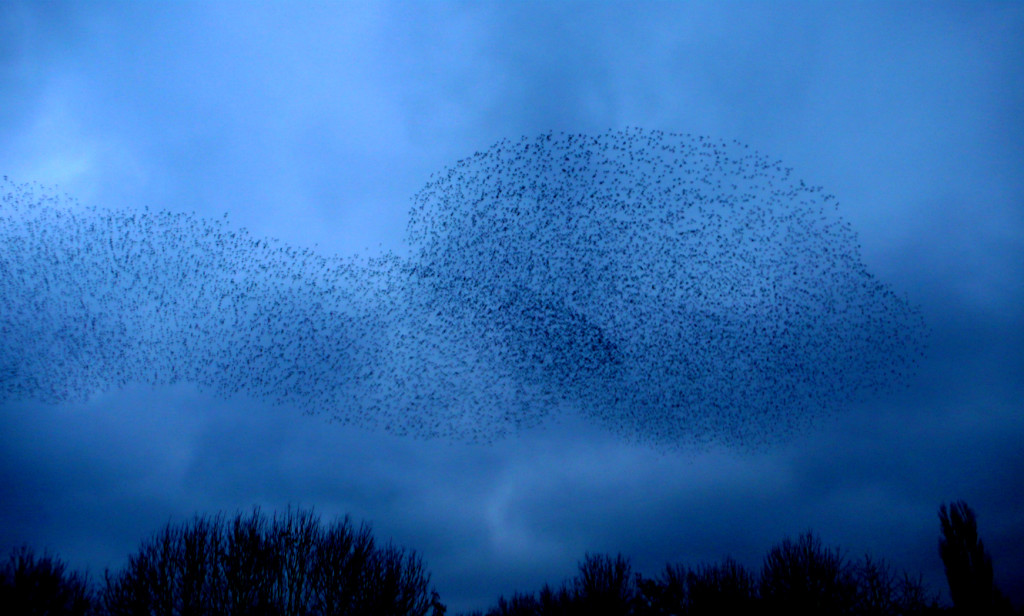Imagine the Starling: Peak Fighter, the Swarm, and the Future of Air Combat

Software is eating the war, and it’s coming for airpower. In the future, air dominance will be determined not by large, non-expendable fifth-generation platforms, but by nimble drone swarms. The only way to stay ahead of the curve and ensure American air dominance is to begin designing the sixth-generation “fighter” as a rapidly reprogrammable adaptive aerial network. Because the next critical performance envelope isn’t hardware — it’s software.
At the opening of the 20th century, the next hundred years of military aviation could be discerned in the ungainly biplanes whose control surfaces and engines form the aeronautical foundations of today’s sleek supersonic fighters. Wings, engines, pilot/bombardier, and the occasional air-to-air weapons system. Man plus machine, optimized to meet target.
From the Wright brothers to Skunk Works, aircraft continued their march towards modernity. Higher. Faster. Sleeker. Deadlier. And while scramjets and laser weapons offer potential improvements towards the asymptote of instant death from above, we are, for all intents and purposes, nearing what we might call “peak fighter.”
In dogfights of old, fighter pilots squared off like gunslingers in engagements that mimicked sporting challenges: one on one, four on three, six on seven. These were human-scale engagements in human-scale platforms to achieve human-scale ends.
With the proliferation of additive (3D) manufacturing and commercially available drones, it is likely that air-to-air engagement will shift from human-scale to digital. Smaller platforms. Smaller payloads. With printable, payload-carrying drones and cheap processing power, how far away are we from a few thousand quadcopters and a cheap machine learning algorithm deploying them as aerial three-dimensional pickets — or some similar heretofore unimagined asymmetric hack? Once that happens, we will need countermeasures, and will suddenly find ourselves entering a swarm-on-swarm scenario with aerial force that was designed for just the opposite type of combat.
What might swarm-on-swarm air combat look like? To tackle one possible answer, consider the starling.
Go to YouTube and search for the word “starling” and you’ll see that swarm engagements won’t look anything like human-driven air combat.
Swarm air combat at scale (say, a 1,000-on-1,000 engagement) may mean that in a single second, a single small air combat vehicle might considered to be “engaged” with 10–20 enemy drones as it banks through a cloud of hostile platforms, firing when the Venn diagram of “firing solutions” and “current scheme of maneuver” overlap by the microsecond.
The only way to prepare for this future is to design platforms that are open and reprogrammable on the fly. Why reprogrammable? Because swarm software will need to evolve in real time to adapt to the enemy swarm. Just like today’s hardware, drone swarm software will have a performance envelope just as likely to determine victory as the actual physical parameters of the platform.
Combat philosopher John Boyd understood that platforms could enable victory by allowing their pilots to rapidly change their speed, angle of attack, and position. Boyd’s efforts produced some of the most nimble, and lethal aircraft in history. But the Boydian approach to air combat assumes a human operator cycling from the Observe-Orient-Decide-Act cycle. In swarm combat, that cycle is being executed by software. And the cycling is happening at nearly the speed of light.
In drone warfare, enemy operating systems will become important targets of intelligence collection. Confronting an unknown schema of maneuver, vulnerability data will begin to roll in within seconds of engagement, at which point human or machine analysis will be able to evaluate potential platform and software weaknesses. At this point, we will need the ability to reprogram our swarms on the fly to capitalize on enemy weaknesses — an OODA loop on the operating system level.
Unless the defense-industrial complex takes seriously the fact that the hardware and software ought to be treated as separate and complementary, we are doomed to be overtaken by those who do. In a world where the ability to perceive, understand, analyze, and counter enemy algorithms makes the difference in combat, Moore’s Law will make the difference in air-to-air combat.
Were Boyd coming of age in the era of semiconductors, he might have better defined Orientation as both biological and digital processing power. To remain dominant in the skies, the United States must build platforms that can take advantage of computational upside through rapid upgrades of both operating systems and processors.
Joshua Steinman is a former member of the Chief of Naval Operations’ Rapid Innovation Cell. He left active duty in 2015, and now runs Special Projects at ThinAir, a digital security startup company in San Francisco. In his spare time he is a Senior Visiting Research Fellow at National Defense University.
Photo credit: Tim Regan (adapted by WOTR)

